Numerical Modeling on the Fracturing and Energy Evolution of Large Deep Underground Openings Subjected to Dynamic Disturbance
Abstract
1. Introduction
2. A Caving Case Induced by Dynamic Disturbances
3. Numerical Model
3.1. Boundary Conditions for the Static Solution
3.2. Material Parameters
3.3. Solution of Geo-Stress
3.4. Boundary Conditions for the Dynamic Solution
4. Numerical Results Analysis
4.1. Energy Evolution around a Large Deep Stope
4.1.1. SED Evolution around the Stope
Model I
Model II
4.1.2. Time History of SED
4.2. Fracturing under Different Dynamic Stress Amplitudes
5. Discussion
6. Conclusions
Author Contributions
Funding
Acknowledgments
Conflicts of Interest
References
- Zhai, X.; Huang, G.; Chen, C.; Li, R. Combined supporting technology with bolt-grouting and floor pressure-relief for deep chamber: An underground coal mine case study. Energies 2018, 11, 67. [Google Scholar] [CrossRef]
- Wagner, H. Deep mining: A rock engineering challenge. Rock Mech. Rock Eng. 2019, 52, 1417–1446. [Google Scholar] [CrossRef]
- Ranjith, P.G.; Zhao, J.; Ju, M.; De Silva, R.V.S.; Rathnaweera, T.D.; Bandara, A.K.M.S. Opportunities and Challenges in Deep Mining: A Brief Review. Engineering 2017, 3, 546–551. [Google Scholar] [CrossRef]
- Hu, J.; Yang, C.; Zhou, K.; Li, J.; Gao, F. Stability of undercut space in fragment orebody based on key block theory. Trans. Nonferrous Met. Soc. China 2016, 26, 1946–1954. [Google Scholar] [CrossRef]
- Fan, D.; Liu, X.; Tan, Y.; Song, S.; Gu, Q.; Yan, L.; Xu, Q. Roof cutting parameters design for gob-side entry in deep coal mine: A case study. Energies 2019, 12, 2032. [Google Scholar] [CrossRef]
- Yang, J.; Yao, C.; Jiang, Q.; Lu, W.; Jiang, S. 2D numerical analysis of rock damage induced by dynamic in-situ stress redistribution and blast loading in underground blasting excavation. Tunn. Undergr. Space Technol. 2017, 70, 221–232. [Google Scholar] [CrossRef]
- Wang, X.; Li, S.; Xu, Z.; Xue, Y.; Hu, J.; Li, Z. An interval fuzzy comprehensive assessment method for rock burst in underground caverns and its engineering application. Bull. Eng. Geol. Environ. 2019, 78, 5161–5176. [Google Scholar] [CrossRef]
- Yang, Y.; Wei, S.; Zhao, S. Research on the destructional pattern of surrounding rock of roadway induced by dynamic disturbance. Geotech. Geol. Eng. 2019, 37, 4447–4459. [Google Scholar] [CrossRef]
- Hamdi, E.; Bouden Romdhane, N.; du Mouza, J.; Le Cleac’h, J.M. Fragmentation energy in rock blasting. Geotech. Geol. Eng. 2008, 26, 133–146. [Google Scholar] [CrossRef]
- Yang, L.; Huang, C.; Bao, S.; Zhang, L. Model experimental study on controlled blasting of slit charge in deep rock mass. Soil Dyn. Earthq. Eng. 2020, 138, 106318. [Google Scholar] [CrossRef]
- Li, X.; Gong, F.; Tao, M.; Dong, L.; Du, K.; Ma, C. Failure mechanism and coupled static-dynamic loading theory in deep hard rock mining: A review. J. Rock Mech. Geotech. Eng. 2017, 9, 767–782. [Google Scholar] [CrossRef]
- Kouame, K.J.A.; Jiang, F.; Zhu, S. Research on cause of dynamic disaster of deep mining control in china and its further prevention application in ivory coast. Geotech. Geol. Eng. 2017, 35, 1141–1149. [Google Scholar] [CrossRef]
- Li, C.; Li, X.; Liang, L. Dynamic response of existing tunnel under cylindrical unloading wave. Int. J. Rock Mech. Min. Sci. 2020, 131, 104342. [Google Scholar] [CrossRef]
- Karampinos, E.; Hadjigeorgiou, J.; Hazzard, J.; Turcotte, P. Discrete element modelling of the buckling phenomenon in deep hard rock mines. Int. J. Rock. Mech. Min. Sci. 2015, 80, 346–356. [Google Scholar] [CrossRef]
- Su, G.; Feng, X.; Wang, J.; Jiang, J.; Hu, L. Experimental study of remotely triggered rockburst induced by a tunnel axial dynamic disturbance under true-triaxial conditions. Rock Mech. Rock Eng. 2017, 50, 2207–2226. [Google Scholar] [CrossRef]
- Li, X.; Li, C.; Cao, W.; Tao, M. Dynamic stress concentration and energy evolution of deep-buried tunnels under blasting loads. Int. J. Rock Mech. Min. Sci. 2018, 104, 131–146. [Google Scholar] [CrossRef]
- Zhu, Y.; Peng, G. Similar material simulation research on movement law of roof over-lying strata in stope of fully mechanized caving face with large mining height. J. Coal Sci. Eng. 2010, 16, 6–10. [Google Scholar] [CrossRef]
- Zhang, X.; Wen, Z.; Liu, J.; Luo, L.; Sun, B. Research on distribution and evolution laws of surrounding rock stress during the island panel mining in multiple complex stope. Geotech. Geol. Eng. 2019, 37, 3355–3366. [Google Scholar] [CrossRef]
- Li, C.; Li, X. Influence of wavelength-to-tunnel-diameter ratio on dynamic response of underground tunnels.subjected to blasting loads. Int. J. Rock Mech. Min. Sci. 2018, 112, 323–338. [Google Scholar] [CrossRef]
- Wang, Z.; Dou, L.; Wang, G. Mechanism analysis of roadway rockbursts induced by dynamic mining loading and its application. Energies 2018, 11, 2313. [Google Scholar] [CrossRef]
- Kong, P.; Jiang, L.; Jiang, J.; Wu, Y.; Chen, L.; Ning, J. Numerical analysis of roadway rock-burst hazard under superposed dynamic and static loads. Energies 2019, 12, 3761. [Google Scholar] [CrossRef]
- Li, D.; Gao, F.; Han, Z.; Zhu, Q. Experimental evaluation on rock failure mechanism with combined flaws in a connected geometry under coupled static-dynamic loads. Soil Dyn. Earthq. Eng. 2020, 132, 106088. [Google Scholar] [CrossRef]
- Cui, F.; Zhang, T.; Lai, X.; Cao, J.; Shan, F. Study on the evolution law of overburden breaking angle under repeated mining and the application of roof pressure relief. Energies 2019, 12, 4513. [Google Scholar] [CrossRef]
- Ramamurthy, T. Realistic parameters adoption to solve rock engineering problems. Indian Geotech. J. 2018, 48, 595–614. [Google Scholar] [CrossRef]
- Feng, F.; Chen, S.; Li, D.; Hu, S.; Huang, W.; Li, B. Analysis of fractures of a hard rock specimen via unloading of central hole with different sectional shapes. Energy Sci. Eng. 2019, 7, 2265–2286. [Google Scholar] [CrossRef]
- Liu, C.; Deng, J.; Yu, S.; Lin, Y. Effect of freezing and thawing on microstructure damage and dynamic flexural tension of granite. Rock Mech. Rock Eng. 2002, 53, 3853–3858. [Google Scholar] [CrossRef]
- Smoljanović, H.; Živaljić, N.; Nikolić, Ž. A combined finite-discrete element analysis of dry stone masonry structures. Eng. Struct. 2013, 52, 89–100. [Google Scholar] [CrossRef]
- Yang, C.; Hu, J.; Ma, S. Numerical investigation of rock breaking mechanism with supercritical carbon dioxide jet by SPH-FEM approach. IEEE Access 2019, 7, 55485–55495. [Google Scholar] [CrossRef]
- Wu, C.; Hao, H.; Lu, Y. Dynamic response and damage analysis of masonry structures and masonry infilled RC frames to blast ground motion. Eng. Struct. 2005, 27, 323–333. [Google Scholar] [CrossRef]
- Luo, X.; Wei, J.; Gao, F.; Xiong, X. Optimization of stope width for steeply inclined thick ore-body in deep mine. Metal Mine 2018, 6, 7–10. [Google Scholar]
- Ahmed, L.; Ansell, A. Structural dynamic and stress wave models for the analysis of shotcrete on rock exposed to blasting. Eng. Struct. 2012, 35, 11–17. [Google Scholar] [CrossRef]
- Wei, X.; Zhao, Z.; Gu, J. Numerical simulations of rock mass damage induced by underground explosion. Int. J. Rock Mech. Min. Sci. 2009, 46, 1206–1213. [Google Scholar] [CrossRef]
- Murray, Y.D. Users Manual for LS-DYNA Concrete Material Model 159. Available online: https://rosap.ntl.bts.gov/view/dot/38730 (accessed on 15 October 2020).
- Tu, Z.; Yong, L. Evaluation of typical concrete material models used in hydrocodes for high dynamic response simulations. Int. J. Impact Eng. 2009, 36, 132–146. [Google Scholar] [CrossRef]
- Li, X.; Weng, L. Numerical investigation on fracturing behaviors of deep-buried opening under dynamic disturbance. Tunn. Undergr. Space Technol. 2016, 54, 61–72. [Google Scholar] [CrossRef]
- Tao, M.; Li, X.; Wu, C. Characteristics of the unloading process of rocks under high initial stress. Comput. Geotech. 2012, 45, 83–92. [Google Scholar] [CrossRef]
- Low, H.Y.; Hao, H. Reliability analysis of reinforced concrete slabs under explosive loading. Struct Saf. 2001, 23, 157–178. [Google Scholar] [CrossRef]
- Gao, F.; Zhou, K.; Luo, X.; Zhai, J. Effect of induction unloading on weakening of rock mechanics properties. Trans. Nonferrous. Met. Soc. China 2012, 22, 419–424. [Google Scholar] [CrossRef]
- Wang, X.; Ma, J.; Liu, L. Numerical simulation of failed zone propagation process and anomalies related to the released energy during a compressive jog intersection. J. Mech. Mater. Struct. 2010, 5, 1007–1022. [Google Scholar] [CrossRef]
- Gu, S.; Zhang, W.; Jiang, B.; Hu, C. Case of rock burst danger and its prediction and prevention in tunneling and mining period at an irregular coal face. Geotech. Geol. Eng. 2019, 37, 2545–2564. [Google Scholar] [CrossRef]
- Shang, J.; Hencher, S.R.; West, L.J. Tensile strength of geological discontinuities including incipient bedding, rock joints and mineral veins. Rock Mech. Rock Eng. 2016, 49, 4213–4225. [Google Scholar] [CrossRef]
- Yang, C.; Zhou, K.; Gao, R.; Xiong, X. Numerical investigation of the dynamic response of a preconditioned roof in an underground mine: A case study of mining environment regeneration. Soil Dyn. Earthq. Eng. 2020, 140, 106457. [Google Scholar] [CrossRef]
- Zhou, K.; Li, Z.; Gao, R. Study of the mechanical law and disturbance-response characteristics during deep-filling mining. Mater. Technol. 2019, 53, 583–593. [Google Scholar] [CrossRef]
- Qiu, J.; Li, X.; Li, D.; Zhao, Y.; Hu, C.; Liang, L. Physical model test on the deformation behavior of an underground tunnel under blasting disturbance. Rock Mech. Rock Eng. 2020, 1–18. [Google Scholar] [CrossRef]
- Qiu, J.; Li, D.; Li, X.; Zhu, Q. Numerical investigation on the stress evolution and failure behavior for deep roadway under blasting disturbance. Soil Dyn. Earthq. Eng. 2020, 137, 106278. [Google Scholar] [CrossRef]
- Konicek, P.; Soucek, K.; Stas, L.; Singh, R. Long-hole destress blasting for rockburst control during deep underground coal mining. Int. J. Rock Mech. Min. Sci. 2013, 61, 141–153. [Google Scholar] [CrossRef]
- Tang, Z.; Liu, X.; Xu, Q.; Li, C.; Qin, P. Stability evaluation of deep-buried TBM construction tunnel based on microseismic monitoring technology. Tunn. Undergr. Space Technol. 2018, 81, 512–524. [Google Scholar] [CrossRef]
- Asim, K.M.; Idris, A.; Iqbal, T.; Martínez-Álvarez, F. Seismic indicators based earthquake predictor system using Genetic Programming and AdaBoost classification. Soil Dyn. Earthq. Eng. 2018, 111, 1–7. [Google Scholar] [CrossRef]
- Sun, J.; Wang, L.; Hou, H. Application of micro-seismic monitoring technology in mining engineering. Int. J. Min. Sci. Technol. 2012, 22, 79–83. [Google Scholar] [CrossRef]
- Zhao, Y.; Yang, T.; Zhang, P.; Zhou, J.; Yu, Q.; Deng, W. The analysis of rock damage process based on the microseismic monitoring and numerical simulations. Tunn. Undergr. Space Technol. 2017, 69, 1–17. [Google Scholar] [CrossRef]



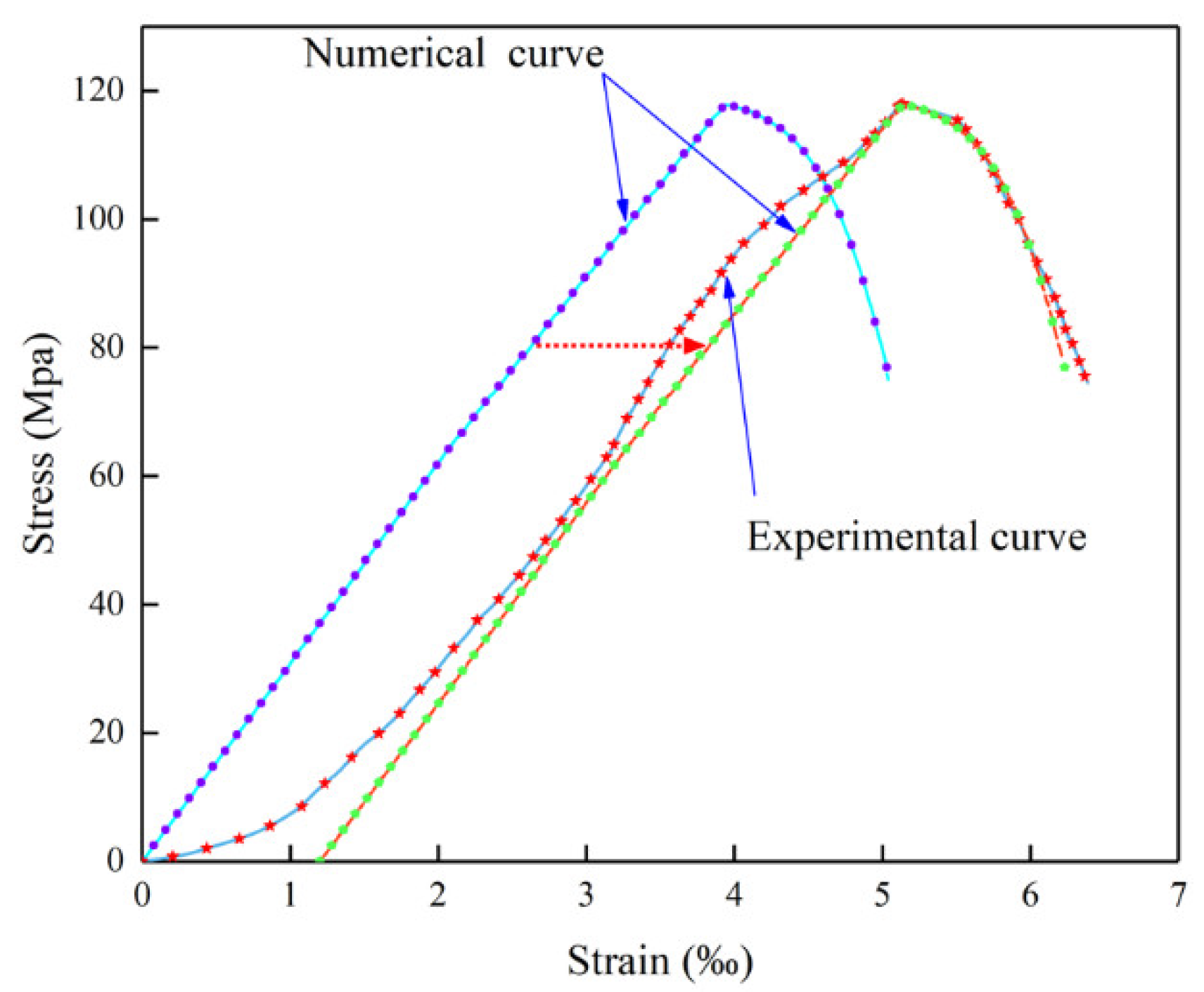
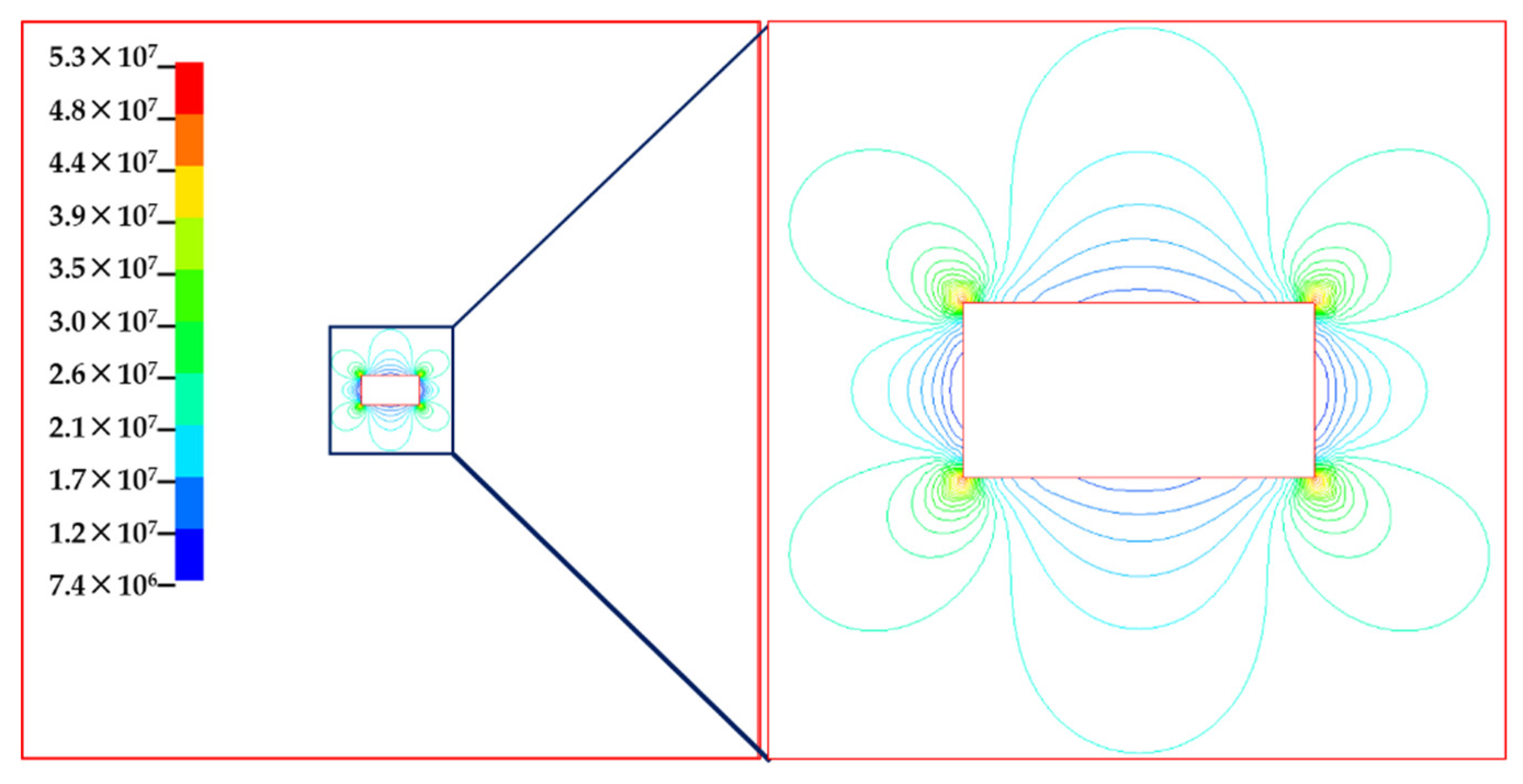

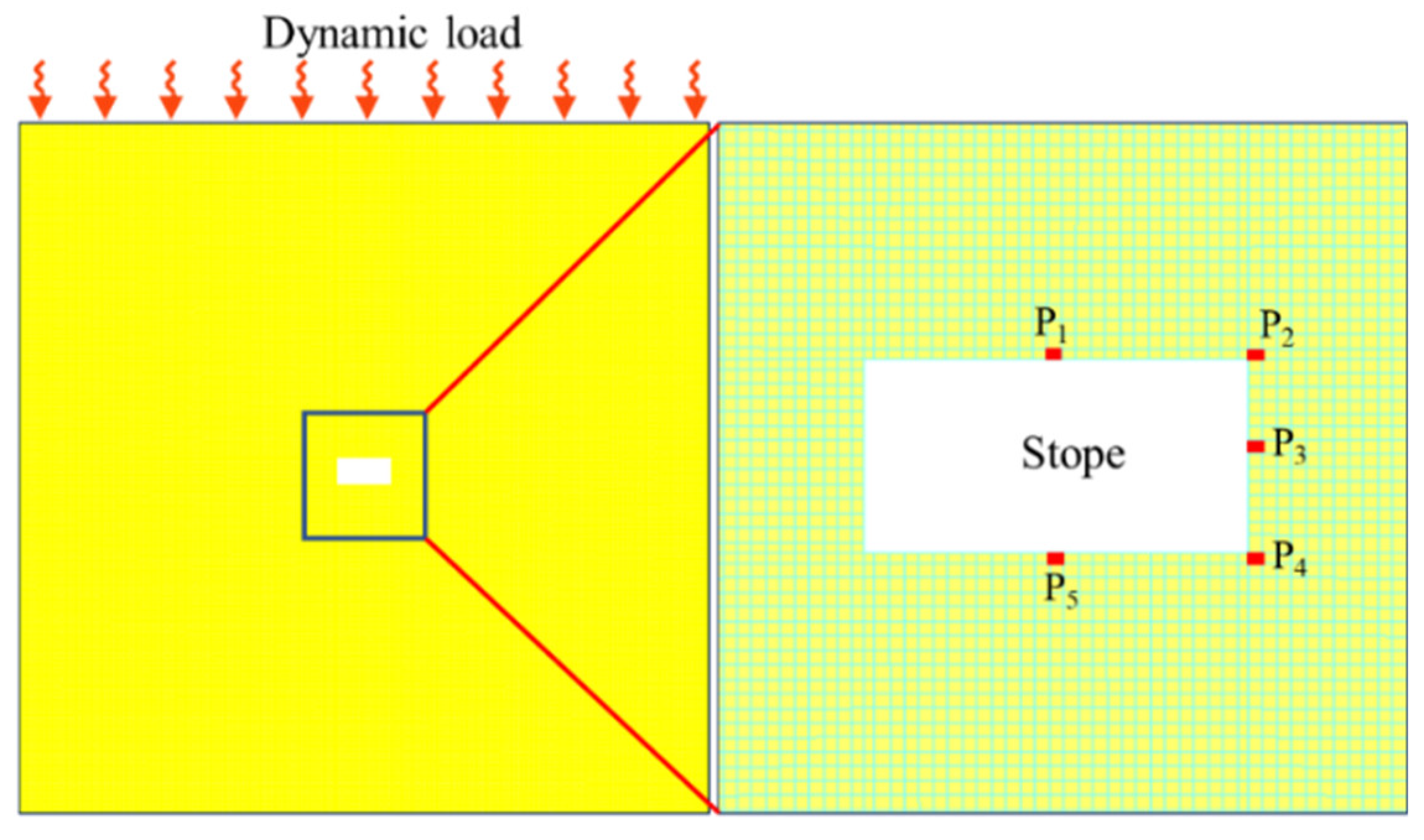

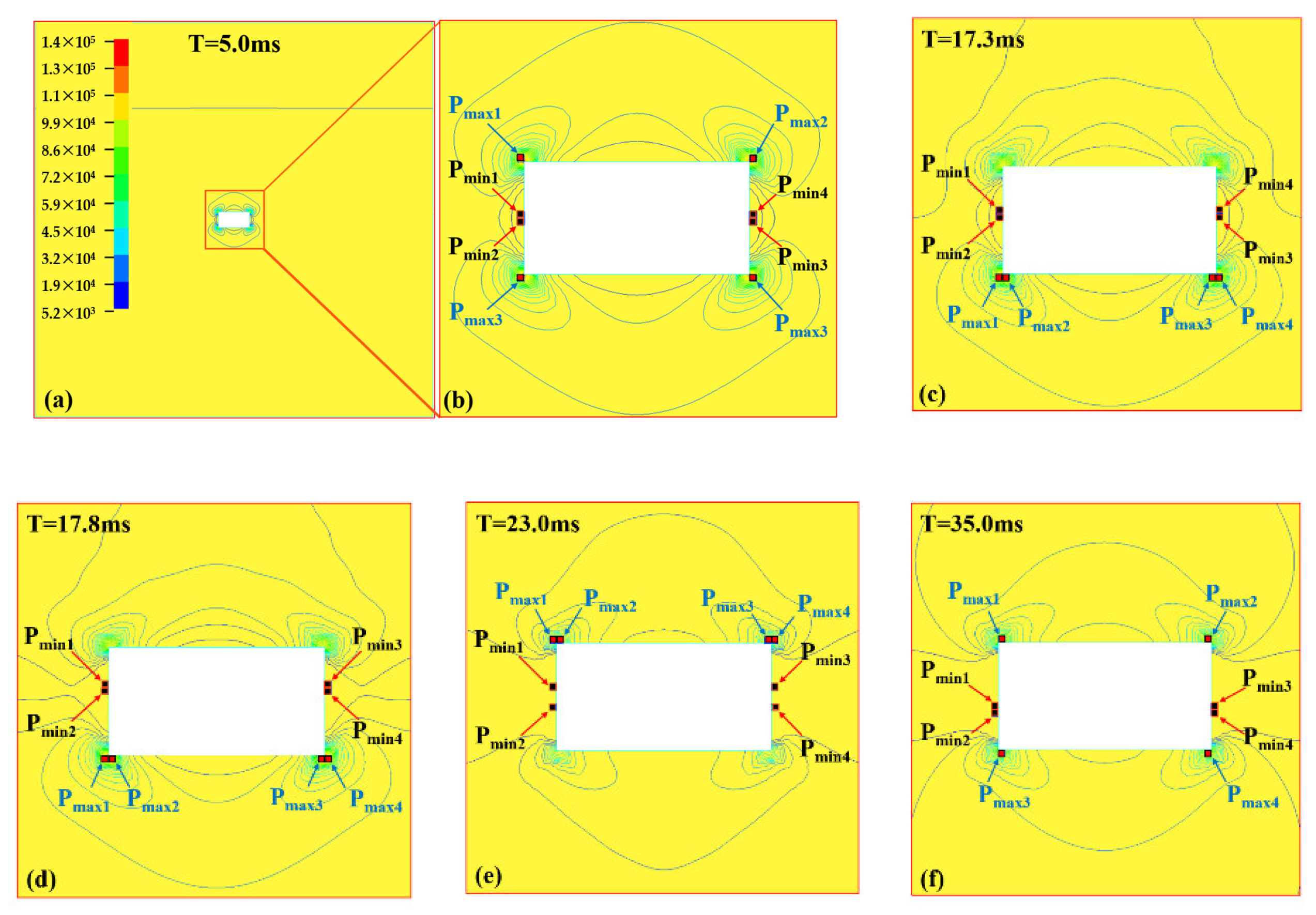


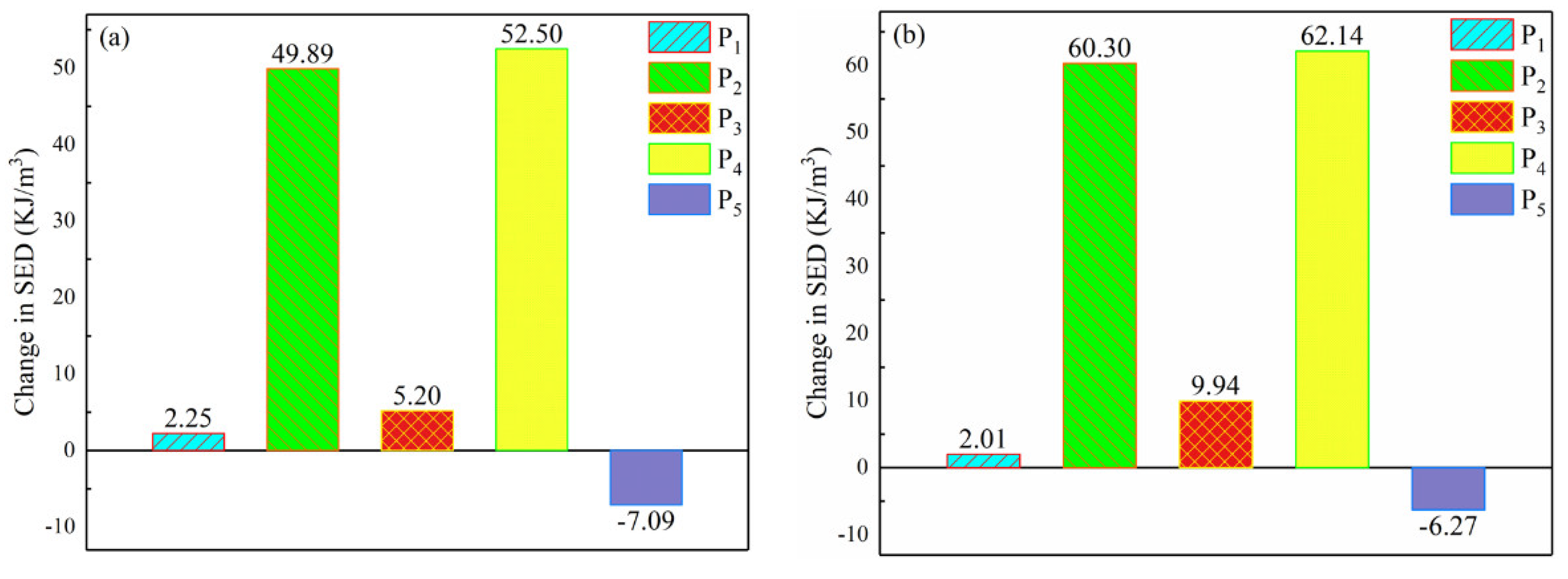


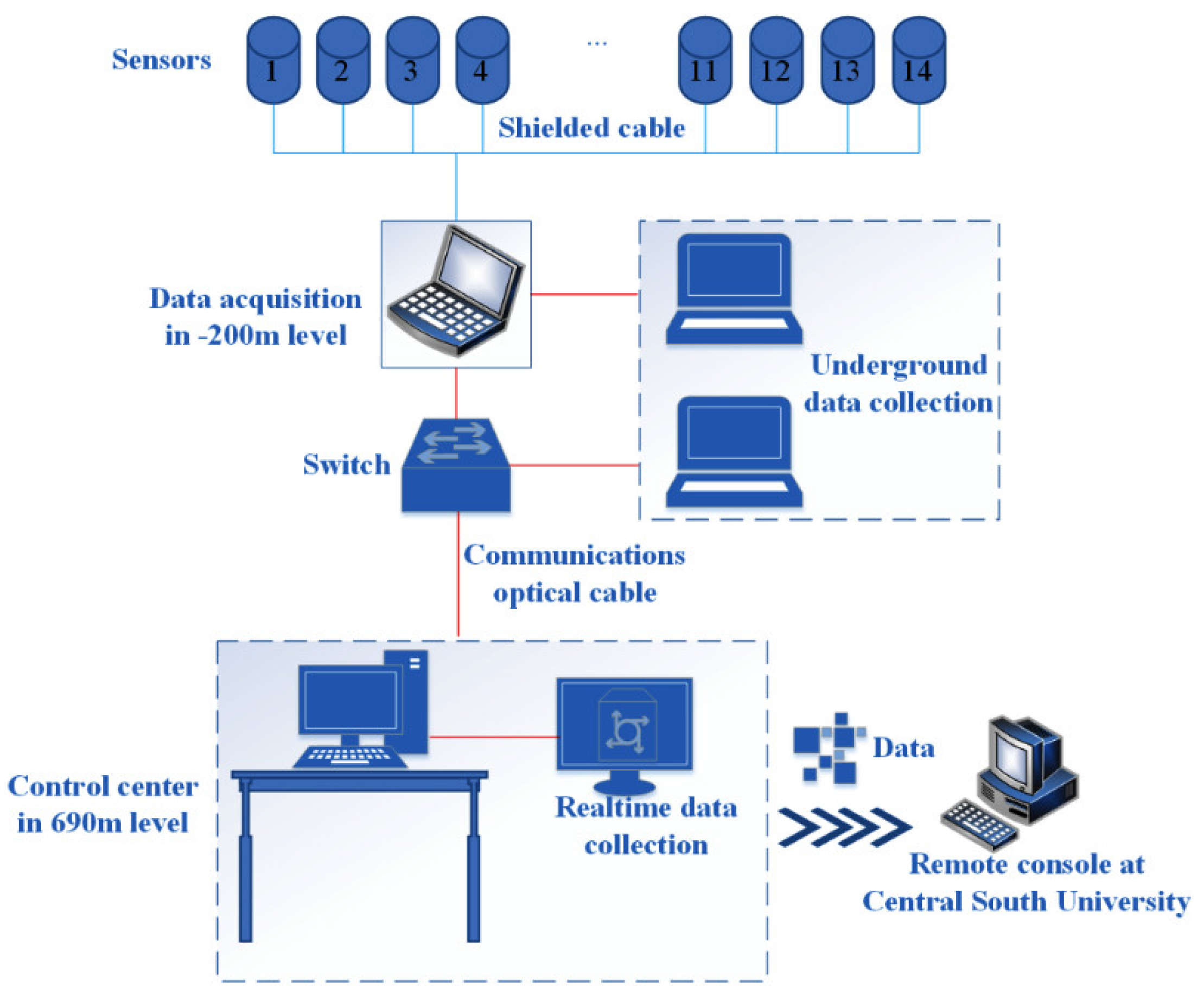
| Density (kg/m3) | Bulk Modulus (GPa) | Shear Modulus (GPa) | Uniaxial Compressive Strength (MPa) | Uniaxial Tensile Strength (MPa) | - |
|---|---|---|---|---|---|
| 4200.00 | 17.80 | 12.30 | 117.84 | 4.20 | - |
| TXC surface | (MPa) | (MPa−1) | (MPa) | - | |
| 10.74 | 1.93 × 10−2 | 10.50 | 0.56 | - | |
| TOR surface | (MPa−1) | (MPa−1) | - | ||
| 0.75 | −1.79 × 10−1 | 0.17 | −5.12 × 10−2 | - | |
| TXE surface | (MPa−1) | (MPa−1) | - | ||
| 0.66 | −0.18 | 0.16 | −5.36 × 10−3 | - | |
| Cap and hardening parameters | Cap aspect ratio | Cap initial location (MPa) | Maximum plastic volume compaction | Linear shape parameter (MPa) | Quadratic shape parameter (MPa2) |
| 5.00 | 202.30 | 0.05 | 0.25 × 10−3 | 0.35 × 10−6 | |
| Fracture energy | Fracture energy in uniaxial stress (Pa·m) | Fracture energy in uniaxial tension (Pa·m) | Fracture energy in pure shear stress (Pa·m) | - | - |
| 6000.00 | 60.00 | 60.00 | - | - | |
| Strain rate parameters | Rate effects parameter for uniaxial compressive stress | Rate effects power for uniaxial compressive stress | Rate effects parameter for uniaxial tensile stress | Rate effects power for uniaxial tensile stress | - |
| 3.08 × 10−4 | 0.49 | 5.07 × 10−5 | 0.78 | - |
Publisher’s Note: MDPI stays neutral with regard to jurisdictional claims in published maps and institutional affiliations. |
© 2020 by the authors. Licensee MDPI, Basel, Switzerland. This article is an open access article distributed under the terms and conditions of the Creative Commons Attribution (CC BY) license (http://creativecommons.org/licenses/by/4.0/).
Share and Cite
Yang, C.; Zhou, K.; Li, Z.; Xiong, X.; Lin, Y.; Luo, Z. Numerical Modeling on the Fracturing and Energy Evolution of Large Deep Underground Openings Subjected to Dynamic Disturbance. Energies 2020, 13, 6102. https://doi.org/10.3390/en13226102
Yang C, Zhou K, Li Z, Xiong X, Lin Y, Luo Z. Numerical Modeling on the Fracturing and Energy Evolution of Large Deep Underground Openings Subjected to Dynamic Disturbance. Energies. 2020; 13(22):6102. https://doi.org/10.3390/en13226102
Chicago/Turabian StyleYang, Chun, Keping Zhou, Zhichao Li, Xin Xiong, Yun Lin, and Zengwu Luo. 2020. "Numerical Modeling on the Fracturing and Energy Evolution of Large Deep Underground Openings Subjected to Dynamic Disturbance" Energies 13, no. 22: 6102. https://doi.org/10.3390/en13226102
APA StyleYang, C., Zhou, K., Li, Z., Xiong, X., Lin, Y., & Luo, Z. (2020). Numerical Modeling on the Fracturing and Energy Evolution of Large Deep Underground Openings Subjected to Dynamic Disturbance. Energies, 13(22), 6102. https://doi.org/10.3390/en13226102






